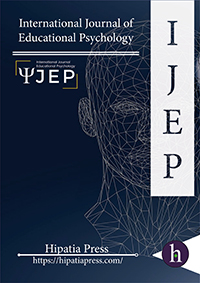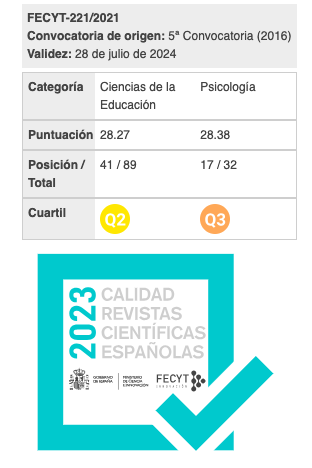Examining the Effects of Text Genre and Structure on Fourth- and Fifth-Grade Students’ High-Level Comprehension as Evidenced in Small-Group Discussions
Keywords:
Downloads
Abstract
Although there is a rich literature on the role of text genre and structure on students’ literal comprehension, more research is needed regarding the role of these text features on students’ high-level comprehension as evidenced in their small-group discussions. As such, the present study examined the effects of text genre (i.e., narrative and informational) and structure (i.e., story, comparison, causation, problem/solution, and sequence) on fourth- and fifth-grade students’ small-group discussions, and the text-based discussions were coded for high-level comprehension discourse indicators (i.e., authentic questions, elaborated explanations, and exploratory talk). The results indicated that students evidenced more indices of high-level comprehension when discussing narrative texts than when discussing informational texts. Meanwhile, teachers tended to initiate more questions in discussions on informational texts. The deeper structure of the texts was also shown to influence the discussions. Specifically, students generated significantly more authentic questions during discussions on texts with comparison structures than for any of the other four text structures, while causation structure texts triggered more authentic questions from teachers. Overall, this study contributes to the understanding of the effects of text factors on students’ high-level comprehension.
Downloads
References
Alexander, P. A., & Jetton, T. L. (2000). Learning from text: A multidimensional and developmental perspective. In M. L. Kamil, P. B. Mosenthal, P. D. Pearson, & R. Barr (Eds.), Handbook of reading research (Vol. 3) (pp. 285-310). Mahwah, NJ: Erlbaum.
Google Scholar CrossrefAlexander, P. A., Kulikowich, J. M., & Schulze, S. K. (1994). How subject-matter knowledge affects recall and interest. American Educational Research Journal, 31, 313-337.
Google Scholar CrossrefAnderson, R. C., Chinn, C., Waggoner, M., & Nguyen, K. (1998). Intellectually stimulating story discussions. In J. Osborn & F. Lehr (Eds.), Literacy for all: Issues in teaching and learning (pp. 170-186). New York: Guilford Press.
Google Scholar CrossrefApplebee, A. N. (1978). Child’s concept of story: Ages 2-17. Chicago: University of Chicago Press.
Google Scholar CrossrefAuthor (1998).
Google Scholar CrossrefAuthor (2008).
Google Scholar CrossrefAuthor (2008).
Google Scholar CrossrefAuthor (2009).
Google Scholar CrossrefAuthor (2010).
Google Scholar CrossrefBeck, I. L., & McKeown, M. G. (2006). Improving comprehension with questioning the author: A fresh and enhanced view of a proven approach. NY: Scholastic, Inc.
Google Scholar CrossrefBillings, L., & Fitzgerald, J. (2002). Dialogic discussion and the Paideia Seminar. American Educational Research Journal, 39, 907-941.
Google Scholar CrossrefChinn, C. A., Anderson, R. C., & Waggoner, M. A. (2001). Patterns of discourse in two kinds of literature discussion. Reading Research Quarterly, 36, 378-411.
Google Scholar CrossrefDuke, N. K. (2000). 3.6 minutes per day: The scarcity of informational texts in first grade. Reading Research Quarterly, 35, 202-224.
Google Scholar CrossrefDuke, N. K. (2005). Comprehension of what for what: Comprehension as a non-unitary construct. In S. G. Paris & S. A. Stahl (Eds.), Current issues in reading comprehension and assessment (pp. 93-104). Mahwah, NJ: Erlbaum.
Google Scholar CrossrefDuchan, J. (2004). Frame work in language and literacy: From theory to practice. NY: Guilford Press.
Google Scholar CrossrefEeds, M., & Wells, D. (1989). Grand Conversations: An exploration of meaning construction in literature study groups. Research in the Teaching of English, 23, 4-29.
Google Scholar CrossrefFitzgerald, J. (1984). The relationship between reading ability and expectations for story structures. Discourse Processes, 7, 21-41.
Google Scholar CrossrefGersten, R., Fuchs L. S., Williams, J. P., & Baker, S. (2001). Teaching reading comprehension strategies to students with learning disabilities: A review of research. Review of Educational Research, 71, 279-320.
Google Scholar CrossrefGoldenberg, C. (1993). Instructional conversations: Promoting comprehension through discussion. The Reading Teacher, 46, 316-326.
Google Scholar CrossrefGreat Books Foundation. (1987). An introduction to shared inquiry. Chicago: Author.
Google Scholar CrossrefHidi, S., & Hildyard, A. (1983). The comparison of oral and written productions in two discourse types. Discourse Processes, 6, 91-105.
Google Scholar CrossrefMandler, J. M., & Johnson, N. S. (1977). Remembrance of things parsed: Story structure and recall. Cognitive Psychology, 9, 111-151.
Google Scholar CrossrefMason, J. M., Peterman, C. L., Powell, B. M., & Kerr, B. M. (1989). Reading and writing attempts by kindergarteners after book reading by teachers. In J. M. Mason (Ed.) Reading and writing connections (pp. 105-120). Boston: Allyn & Bacon.
Google Scholar CrossrefMcKeown, M. G., & Beck, I. L. (1990). The assessment and characterization of young learners’ knowledge of a topic in history. American Educational Research Journal, 27, 688-726.
Google Scholar CrossrefMcNamara, D.S., Louwerse, M.M., Cai, Z., & Graesser, A. (2013). Coh-Metrix version 3.0. Retrieved from http://cohmetrix.com
Google Scholar CrossrefMcNamara, D. S., Ozuru, Y., & Floyd, R. G. (2011). Comprehension challenges in the fourth grade: The roles of text cohesion, text genre, and readers' prior knowledge. International Electronic Journal of Elementary Education, 4, 229-257.
Google Scholar CrossrefMercer, N. (1995). The guided construction of knowledge: Talk amongst teachers and learners. Philadelphia: Multilingual Matters.
Google Scholar CrossrefMercer, N. (2000). Words and Minds: how we use language to think together. London: Routledge.
Google Scholar CrossrefMercer, N. (2002). The art of interthinking. Teaching Thinking, 7, 8-11.
Google Scholar CrossrefMeyer, B. J. F. (1975). The organization of prose and its effects on memory. Amsterdam: North-Holland.
Google Scholar CrossrefMeyer, B. J. F. (2003). Text coherence and readability. Topics in Language Disorders, 23, 204-221.
Google Scholar CrossrefMeyer, B. J. F., Brandt, D. M., & Bluth, G. J. (1980). Use of top-level structure in text: Key for reading comprehension of ninth-grade students. Reading Research Quarterly, 16, 72-103.
Google Scholar CrossrefMeyer, B. J. F., & Freedle, R. O. (1984). Effects of discourse type on recall. American Educational Research Journal, 21, 121-143.
Google Scholar CrossrefMeyer, B. J. F., Young, C. J., & Bartlett, B. J. (1989). Memory improved: enhanced reading comprehension and memory across the life span through strategic text structure. Hillsdale, NJ: Erlbaum.
Google Scholar CrossrefNational Assessment Governing Board. (October 2012). Reading framework for the 2013 National Assessment of Educational Progress. Retrieved from http://www.edpubs.gov/document/ed005373p.pdf
Google Scholar CrossrefNystrand, M., Gamoran, A., Kachur, R., & Prendergast, C. (1997). Opening dialogue: Understanding the dynamics of language and learning in the English classroom. New York: Teachers College Press.
Google Scholar CrossrefNystrand, M., Wu, L., Gamoran, A., Zeiser, S., & Long, D. (2003). Questions in time: Investigating the structure and dynamics of unfolding classroom discourse. Discourse Processes, 35, 135-196.
Google Scholar CrossrefO'Reilly, T., & McNamara, D. S. (2007). Reversing the reverse cohesion effect: Good texts can be better for strategic, high-knowledge readers. Discourse Processes, 43, 121-152.
Google Scholar CrossrefPearson, P. D., & Gallagher, M. C. (1983). The instruction of reading comprehension. Contemporary Educational Psychology, 8, 317-344.
Google Scholar CrossrefPrice, L. H., Bradley, B. A., & Smith, J. (2012). A comparison of preschool teachers’ talk during storybooks and information book read alouds. Early Childhood Research Quarterly, 27, 426-440.
Google Scholar CrossrefRAND Reading Study Group. (2002). Reading for understanding: Towards an R&D program in reading comprehension. Santa Monica, CA: RAND.
Google Scholar CrossrefRaphael, T. E., & McMahon, S. I. (1994). Book Club: An alternative framework for reading instruction. The Reading Teacher, 48, 102-116.
Google Scholar CrossrefRay, M. (2013). Individual differences in deep level comprehension: Contributions of text structure, comprehension skill, and prior knowledge (Unpublished doctoral dissertation). The Pennsylvania State University, University Park.
Google Scholar CrossrefReninger, K. B., & Wilkinson, I. A. G. (2010). Using discussion to promote striving readers’ higher level comprehension of literary texts. In J. L. Collins and T. G. Gunning (Eds.), Building struggling students’ higher level literacy: Practical ideas, powerful solutions (pp. 57-83). Newark, DE: International Reading Association.
Google Scholar CrossrefResnick, L. B. (1987). Education and learning to think. Washington, DC: National Academy Press.
Google Scholar CrossrefSharp, A. M. (1995). Philosophy for children and the development of ethical values. Early Child Development and Care, 107, 45-55.
Google Scholar CrossrefShort, K. G., & Pierce, K. M. (Eds.) (1990). Talking about books: Creating literate communities. Portsmouth, NH: Heinemann.
Google Scholar CrossrefSmolkin, L. B., & Donovan, C. A. (2002, December). Paradigms and methodologies in genre research. Paper presented at the annual meeting of the National Reading Conference, Miami, FL.
Google Scholar CrossrefSnow, C. E., Burns, M. S., & Griffin, P. (Eds.). (1998). Preventing reading difficulties in young children. Washington, DC: National Academy Press.
Google Scholar CrossrefSpooren, W., Mulder, M., & Hoeken, H. (1998). The role of interest and text structure in professional reading. Journal of Research in Reading, 21, 109-120.
Google Scholar CrossrefStein, N. L., & Glenn, C. G. (1979). An analysis of story comprehension in elementary school children. In R. O. Freedle (Ed.), Advances in discourse processes: New directions in discourse processing (Vol. 2). Norwood, NJ: Ablex.
Google Scholar CrossrefWebb, N. M. (1980). A process-outcome analysis of learning in group and individual settings. Educational Psychologist, 15, 69-83.
Google Scholar CrossrefWebb, N. M. (1991, April). Managing small-group processes in the classroom. Paper presented at the annual meeting of the American Educational Research Association, Chicago.
Google Scholar CrossrefWebb, N. M., Farivar, S. H., & Mastergeorge, A. M. (2001). Productive helping in cooperative groups. Center for the Study of Evaluation, Graduate School of Education, UCLA, Report to the Office of Educational Research and Improvement/Department of Education.
Google Scholar CrossrefWegerif, N., Mercer, N., & Dawes, L. (1999). From social interaction to individual reasoning: an empirical investigation of a possible socio-cultural model of cognitive development. Learning and Instruction, 9, 493-516.
Google Scholar CrossrefDownloads
Published
Almetric
Dimensions
How to Cite
Issue
Section
License
All articles are published under Creative Commons copyright (CC BY). Authors hold the copyright and retain publishing rights without restrictions, but authors allow anyone to download, reuse, reprint, modify, distribute, and/or copy articles as the original source is cited.
















